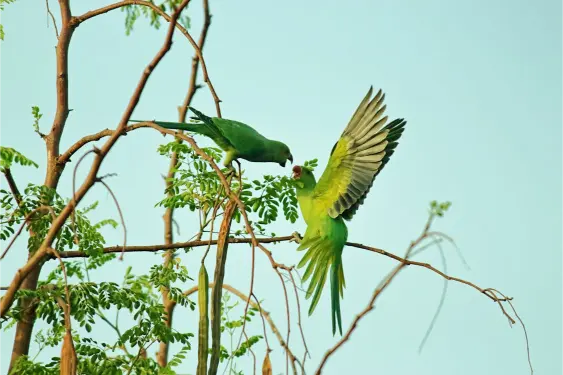The intricate dance between humans and the avian world has long been a subject of fascination and study. Birds, with their melodious songs and vibrant plumage, are more than just a delightful presence in our lives; they are pivotal players in the ecosystem, offering services that, upon closer examination, have profound economic implications. This exploration delves into the concept of economic ornithology, an area of study that seeks to quantify the value of birds in monetary terms, focusing particularly on their role in agriculture and pest control, the challenges in measuring their contributions, and the broader implications for conservation and human well-being.
Economic Ornithology: A Glimpse into Value
Economic ornithology is not a term that many might be familiar with, yet it is a field of study with significant implications for our understanding of ecological balance and economic sustainability. At its core, it involves evaluating the contributions of birds to human economies, especially in terms of pest control and the preservation of crop health. Birds, by feasting on insects and rodents that would otherwise ravage agricultural produce, provide a service that has long been acknowledged but seldom quantified in economic terms.
Historically, the approach to understanding the value of birds has been somewhat rudimentary, focusing on direct observations such as analyzing the contents of a bird’s stomach to determine the number and types of pests consumed. This method, though straightforward, offers invaluable insights into the diet of birds and by extension, their role in controlling pest populations. Such studies have revealed that even species often considered nuisances, like crows, play a beneficial role in agriculture by reducing the number of harmful insects and small animals that can destroy crops.
Methodological Challenges and Modern Approaches
Quantifying the economic value of birds poses significant methodological challenges. Traditional methods relied heavily on direct observation, which, while useful, could not capture the broader ecological impacts or the long-term benefits of avian pest control. Modern research techniques, including randomized controlled trials and ecological modeling, have started to provide a more comprehensive picture of birds’ contributions to agriculture. These studies have demonstrated that the presence of insectivorous birds can lead to measurable improvements in crop yields, highlighting the tangible benefits of biodiversity for food production.
The transition from reliance on pesticides to a more integrated approach to pest management, incorporating natural predators like birds, marks a shift towards sustainable agriculture. However, despite these advances, challenges remain in fully capturing the economic value of birds. Factors such as the variability in bird species’ effectiveness in pest control, the impact of habitat loss, and the ongoing threat posed by pesticides complicate efforts to quantify their contributions precisely.
The Impact of Birds Beyond Agriculture
While the focus on agriculture is paramount, the value of birds extends far beyond crop fields. Birdwatching and ecotourism are significant economic activities, drawing millions of enthusiasts worldwide and contributing to local economies, particularly in areas rich in avian biodiversity. The aesthetic and recreational value of birds, although harder to quantify, plays a crucial role in human well-being and cultural appreciation of nature.
Furthermore, the conservation of bird populations intersects with broader environmental challenges, including climate change and habitat destruction. Efforts to protect bird habitats not only preserve avian diversity but also safeguard ecosystems that are vital for human survival. The economic rationale for bird conservation is thus intertwined with ethical and environmental considerations, underscoring the need for policies that reflect the multifaceted value of birds.
Looking Ahead: Conservation and Coexistence
As understanding of the economic value of birds continues to evolve, so too does the recognition of the need for their protection. Conservation efforts, informed by economic ornithology, can lead to more targeted strategies that balance human economic interests with the imperative of biodiversity preservation. Initiatives such as creating bird-friendly agricultural practices, mitigating the risks of window strikes in urban areas, and addressing the threats posed by domestic cats, highlight the complex interplay between human activities and avian survival.
The future of economic ornithology lies in advancing our understanding of the economic benefits of birds, refining methodologies to capture their value more accurately, and integrating this knowledge into broader conservation and economic planning efforts. As society grapples with environmental challenges, the insights gained from economic ornithology can contribute to a more sustainable and harmonious coexistence between humans and the natural world.
Birds are not merely passive participants in the ecosystem but are active contributors to its health and to human economies. The field of economic ornithology offers a framework for recognizing and valuing these contributions, paving the way for conservation efforts that appreciate the full spectrum of benefits that birds provide. As research continues to unveil the intricate relationships between birds and human activities, it becomes increasingly clear that protecting avian populations is not just an act of environmental stewardship but a wise economic investment.




 By
By![A person sits on a blue chair during a discussion at an event. They appear thoughtful, wearing a dark jacket and a light shirt, with a blue backdrop featuring the text "HUMAN[x]."](https://biztechweekly.com/wp-content/uploads/2025/07/metas-14.3b-scale-ai-investment-sparks-surge-in-competitor-growth-and-client-shifts-in-ai-training-market-870x570.webp)
 By
By
 By
By



 By
By
 By
By
 By
By







![A person sits on a blue chair during a discussion at an event. They appear thoughtful, wearing a dark jacket and a light shirt, with a blue backdrop featuring the text "HUMAN[x]."](https://biztechweekly.com/wp-content/uploads/2025/07/metas-14.3b-scale-ai-investment-sparks-surge-in-competitor-growth-and-client-shifts-in-ai-training-market.webp)